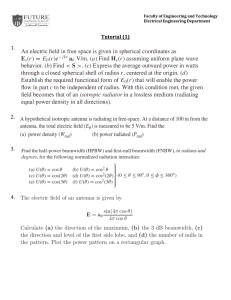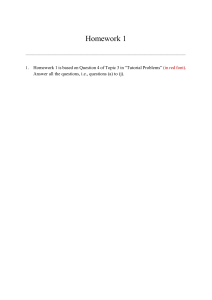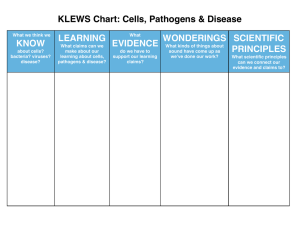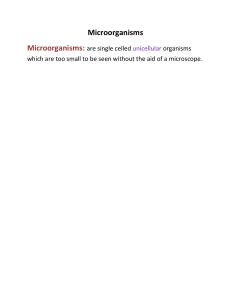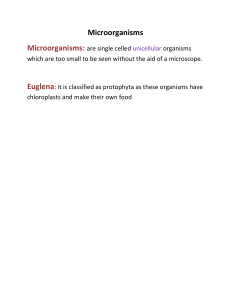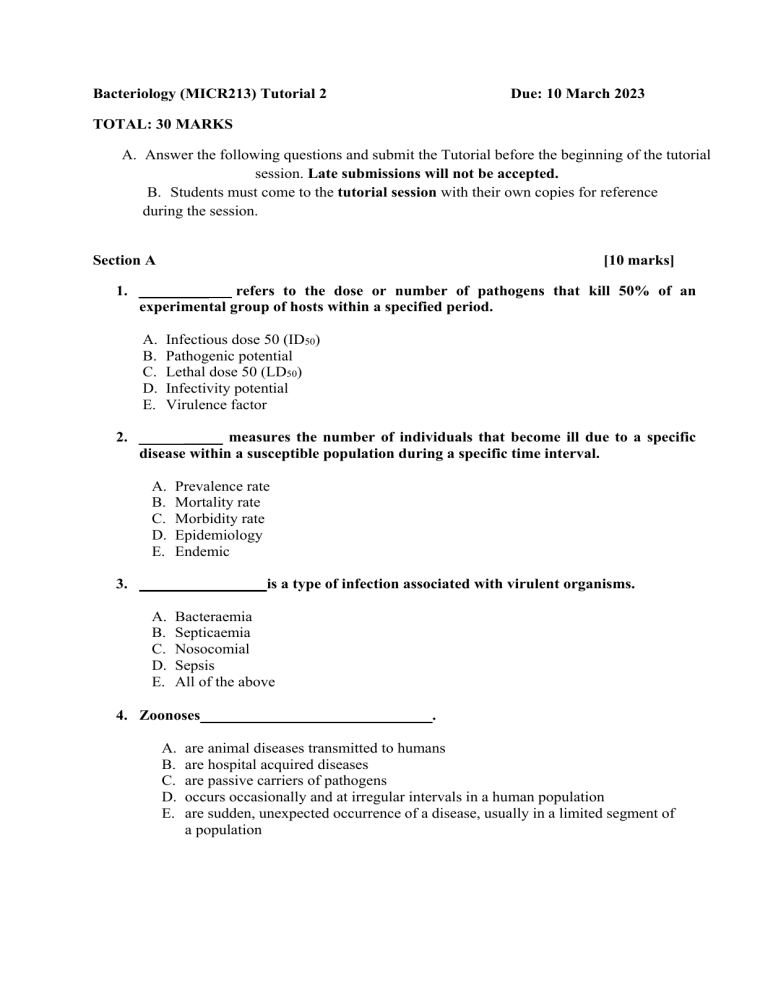
Bacteriology (MICR213) Tutorial 2 Due: 10 March 2023 TOTAL: 30 MARKS A. Answer the following questions and submit the Tutorial before the beginning of the tutorial session. Late submissions will not be accepted. B. Students must come to the tutorial session with their own copies for reference during the session. Section A [10 marks] 1. _________ refers to the dose or number of pathogens that kill 50% of an experimental group of hosts within a specified period. A. B. C. D. E. 2. Infectious dose 50 (ID50) Pathogenic potential Lethal dose 50 (LD50) Infectivity potential Virulence factor _____ measures the number of individuals that become ill due to a specific disease within a susceptible population during a specific time interval. A. B. C. D. E. Prevalence rate Mortality rate Morbidity rate Epidemiology Endemic 3. __________is a type of infection associated with virulent organisms. A. B. C. D. E. Bacteraemia Septicaemia Nosocomial Sepsis All of the above 4. Zoonoses______________________________. A. B. C. D. E. are animal diseases transmitted to humans are hospital acquired diseases are passive carriers of pathogens occurs occasionally and at irregular intervals in a human population are sudden, unexpected occurrence of a disease, usually in a limited segment of a population 5. Putrefaction can be best described as a______________________. A. proteolysis and anaerobic breakdown of proteins, yielding foul-smelling amine compounds B. toxic condition caused by growth of a fungus in grains70% C. carcinogens produced in fungus-infected grains and nut products D. carcinogens produced in fungus-infected corn E. None of the above are correct 6. Which of the following is NOT an intrinsic factor that affect the growth of microorganisms in food? A. B. C. D. E. Water activity (aw) pH Oxidation- reduction potential Nutrient content Temperature 7. Which of the following is NOT an extrinsic factor that affect the growth of microorganisms in food? A. B. C. D. E. Temperature Relative humidity Gases (CO2, O2) present Types and numbers of microorganisms present in the food Biological structure of food 8. Airborne transmission is acquired from_________________. A. B. C. D. E. droplets or dust particles < 1-4 μm diameter coming together or touching of source/reservoir and host inanimate materials or objects involved in pathogen transmission passive carriage of a pathogen on the body of a vector hospitals and/or clinical care facilities 9. Which of the following is NOT part of the primary step in the waste water treatment process? A. B. C. D. E. Removal of insoluble particles by physical procedures Screening the incoming water content Addition of coagulants Settling insoluble particles The use of trickling filters and lagoons 10. Food-Borne intoxications is the_________________________. A. ingestion of toxins in foods in which microbes have grown B. ingestion of microbes, followed by growth, tissue invasion, and/or release of toxins C. ingestion of raw food D. ingestion of Common food pathogens such as Campylobacter, Salmonella, Shigella, Clostridium, Staphylococcus, Escherichia coli. E. Putrefaction process followed by intoxication Section B 1. [20 marks] Provide a term/phrase that best match the following descriptions [5] 1.1. A disease occurring occasionally and at irregular intervals in a human population. 1.2. A disease caused in hospitalized patients by pathogens acquired in a hospital or clinical care facility. 1.3. A disease that maintains a steady, low-level frequency at a moderately regular interval. 1.4. Total number of individuals infected in a population at any one time. 1.5. proteolysis and anaerobic breakdown of proteins, yielding foul-smelling amine compounds 2. Differentiate between prebiotics and probiotics. [2] 3. Name three extrinsic or environmental factors that affect the growth of microorganisms in food. [3] 4. Wastewater treatment involves a number of steps that are spatially segregated. Briefly describe the following stages: 4.1. Primary treatment [2] 4.2. Secondary treatment [2] 4.3. Tertiary treatment [2] 5. Imagine you are the Epidemiologist for the National Department of Health. You have been asked to prepare a National health report for the year 2016 in which there was a sharp increase in listeriosis cases. 5.1. In one month, there were 280 new cases of listeriosis per 100 000 individuals. Calculate the morbidity rate. [2] 6. Differentiate a common-source epidemic from a propagated epidemic. [2]
